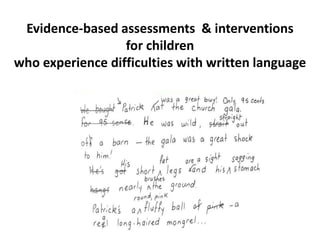Writing
- 1. Evidence-based assessments & interventions for children who experience difficulties with written language
- 2. Writing processes & written productWriting involves planning, drafting, revising and publishing. Writers can have difficulties with any one, or all, of these processes or phases.A piece of writing (product) can reveal the writing strategies and development level of the writer. A comprehensive assessment of a writer involves observing the writing processes (for several different purposes) and analysing the resulting products.
- 3. Genres In the past, most primary-school was either recounts of personal experience (âwhat I did in the holidaysâ) or imaginative narrative (âcreative writingâ). Genre pedagogy says that it is important for children to learn the language use which is more powerful in our society.Opinion and informational writing require different organisation and presentation of ideas than narrative writing.Some writers engage more with ânon-fictionâ writing such as information writing, so it is important for teachers to incorporate a range of writing purposes into their programmes.
- 4. Distinguish between composing and transcribing Childrenâs oral language can reveal their language capabilities, provided they do not have speech difficulties, better than their writing. If it seems to be the making of letters on paper which is constraining a writer, seek alternative ways of transcribing for her/him. Keyboards are more easily controlled than pencils by some children. Having a competent writer to scribe for them on a regular basis can increase feelings of self-efficacy for children with transcribing problems.
- 5. Facilitating writing âScaffoldingâ for learning about writing can be powerful through âmodellingâ â competent writer (the teacher) thinking aloud their mental processing as they write the type of writing which is the goal for the child.Modelling can demonstrate the particular thinking and writing strategies most needed by children with difficulties eg âDinosaurs is too much to write about, so I need to decide on some things. Iâll make a list of what I know, then choose a couple of things from the list âĶâ
- 6. Summary Gather evidence of the writerâs strengths and needs from a range of writing processes and products.List the areas of writing which are difficult for the writer and decide on a priority order in which to address them. Problem solve with the child in providing support where you judge it to be needed to overcome specific high priority difficulties.Give specific praise for attempts to tackle an area of difficulty.
Editor's Notes
- #2: This example of draft writing shows the complexity of the activity of writing. It shows the subsequent thoughts of a writer who adds in details eg âround, pinkâ, who revises sentences âwe boughtâ to create impact and who corrects spelling, eg âstraightâ. These alterations show us that the writer is controlling their language to convey information and create interest for their readers. To assess and support writers who have difficulties, it is necessary to understand the processes involved in writing.
- #3: All writing involves putting thoughts into words (drafting), but some kinds of writing, in some contexts, may only involve drafting. A shopping list will not involve conscious planning about the writing, since the list format becomes automatic for most of us. The list is drafted, the language, being a shorthand, is seldom revised and often the audience is self, so there is no publishing phase. This example shows that the processes are not all involved in all acts of writing, but they represent the potential phases of writing. Observing a writer through the whole process (planning-revising) is necessary to discover where there are difficulties for that writer. As with the opening slide, examples of draft writing show us some of the thought processes of the writer. Information from both the process and the product across several genres is important in forming a full picture of a childâs writing competences and difficulties.
- #4: Personal reflection and invented stories, which were the favoured genres, are not every childâs preferred texts. Allowing children to retell narratives from television or film, and to use images as part of their texts can positively engage some children with literacy. Allowing storyboards, maps, plans or flowcharts to be part of the writing process and product can also engage some reluctant writers.
- #5: âTranscribingâ is the process of recording language in print through pen, pencil or keyboard. âComposingâ is the mental process of assembling language into messages for a receiver. Children who can communicate within a given genre orally, but not in writing, should be supported with transcribing assistance of some kind to express their language potential. In this module, âwritingâ refers to the deeper process of composing and to the ability to transcribe, not just to the physical capability of coding sequences of letters onto paper or into a computer.
- #6: A teacher who has observed a child writing will have a list of areas which create difficulties. The teacher can tailor modelling for that child to focus in turn on the areas and in each instance think aloud a couple of strategies which she thinks may be helpful for the child, providing further scaffolding in terms of starters or writing frames and giving positive feedback to behaviours which show attempts at productive strategies.
- #7: Understanding the learners and their difficulties is the first step. Prioritising the areas of difficulty is second, then generating several possible strategies or supports for that area is next. With some learners, it will be appropriate to model a strategy, offering it as a possible way of dealing with that area. Remember to praise attempts which show the beginnings of productive strategies.





